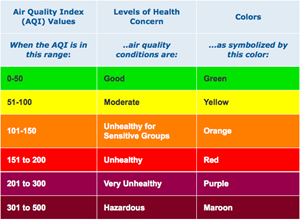Know the Air Quality Index and How to Use It
Know the Air Quality Index and How to Use It
By Unknown
Updated
5 minute read
Dr. Jason Hamula MD, shared how he uses the AQI both professionally and personally. Dr. Hamula bikes to work most days and checks the AQI on his phone several times a day during inversions to determine the best time of day—meaning times when the AQI is lowest—for his commute.
The AQI goes up and down during the day, making it a great tool for planning your day’s activities. But, Dr. Hamula also uses the AQI with patients in his practice at the Salt Lake Clinic. From that information he can usually predict when he’ll see more patients with respiratory diseases, as they tend to be susceptible when the AQI is high. “It’s also an important piece of patient education for these patients and others, so I Increasingly have conversations with patients about how on the worst days—when the AQI is highest—they might need to limit their outdoor activity.”
In order to protect themselves patients need to understand what the AQI is and how to read it, so Dr. Hamula shares with them what he’s learned. “In a sense, the AQI is much like the pollen count that allergy sufferers follow – it’s one more thing in the air that many of us need to be more aware of.”
What is the Air Quality Index?
The Air Quality Index (AQI) is a national system used to measure and report air quality. Managed by the U.S. Environmental Protection Agency, the AQI looks for five major air pollutants regulated by the Clean Air Act: particle pollution, ground-level ozone, carbon monoxide, nitrogen dioxide, and sulfur dioxide. The EPA takes daily readings of these pollutants and interprets it into a specific number ranging from zero to 500 and a specific color.
Of the pollutants they track, ground-level ozone and airborne particles (or particulate matter) are the most harmful to us. Ground-level ozone forms when polluted air comes in contact with heat and sunlight. This is common in the summer months and late in the day.
Particulate matter is tiny particles in the air, like dirt, dust, smoke, and soot, which is reported as either PM 2.5 or PM 10. PM 2.5 particles are very tiny. These particles can get deep into your lungs and cause inflammation and labored breathing. PM 10 particles, like pollen, mold, and dust, are slightly bigger. In Utah, particulate matter pollution is more common and problematic in the winter months.
How to Make Sense of It
All of this may sound complicated, but when broken down it really is quite simple. Basically, when the air quality is good the AQI is low (zero-50) and the color associated with it is green. As the air quality gets worse the number gets higher and the color associated with it becomes a darker shade of red. You can check the AQI level through the national air quality website, AirNow, and the Utah Department of Environmental Quality website. Local radio and TV stations often broadcast the air quality reading as well. Here is an Air Quality Index chart that can help you understand the air quality reports in your area:

Safety Tips for Poor Air Quality Days
Poor air quality is connected with many health problems including cardiovascular disease and respiratory problems like asthma, allergies, pneumonia, and bronchitis. On days where the AQI level is 51 (yellow) or higher, you should be taking steps to limit your exposure. Here are some safety tips you can follow to stay healthy:
- Pay attention to the Air Quality Index: Find out what the air quality is like in your area before you plan your day. You won’t want to go for a long run on a “red” day!
- Minimize your exposure: Avoid exposure to outdoor air in more polluted places, such as high-traffic, industrial areas.
- Go to a higher altitude: Get above the pollution by visiting Utah’s nearby canyons.
- Stay indoors: Your air conditioning and heating units do more than just regulate the temperature in your home. They filter out harmful particles that you would otherwise breathe outdoors. Try exercising indoors on poor air quality days so that you can benefit from this filtered, safer air.
- Limit emissions: Do your part to improve long-term air quality by reducing emissions. Whenever possible, use public transportation or carpool with your family and friends. Also, drive slower on the freeways to increase your vehicle’s efficiency.
- Take medications as directed: If you have a health condition that is aggravated by air pollution, create an air quality action plan with your care provider. Take your medications as directed and make sure you know what to do in case of an emergency. Never increase dosages on your own.
For more information about the Air Quality Index and local air quality reports, visit airnow.gov or airquality.utah.gov.
Sources: